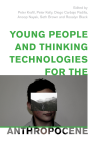Zusammenfassung
This collection, which is a companion volume to Young People and Stories for the Anthropocene (Kelly et al., 2022), aims to find, to explore, and to co-produce ways of ‘staying with the trouble’ (Haraway 2016) that are disruptive of orthodoxies in childhood and youth studies, and productive of new ways of thinking, and of being and becoming, in the circumstances that we (young and old) find ourselves in. Circumstances that have, problematically, been identified as the Anthropocene, and which have been characterised as being situated at the convergence of the climate crisis, the 6th mass extinction, and the ongoing crises of global capitalism as ‘earth system’ (Braidotti 2019, Moore 2015).
The collection emerges, in part, and among other things, around three key challenges. First, how can childhood and youth studies tell stories about the less obviously-bounded, obviously-crafted, obviously-engineered material stuff that humans create and that circulates – stuff like plastics, chemicals, and the scattered remnants of past industrial endeavour. Second, the need to experiment with diverse modes of representation: with differently-mediated technologies and modes of telling that, from digital film platforms to children’s non-fiction writing, expand our lexicon in terms of how it might become possible to narrate young people in/and the Anthropocene. Third, the need to articulate different ‘tools’ for working with young people in the Anthropocene. ‘Tools’ and ‘technologies’, understood in this manner, are modes of becoming-attuned to, and of making, new configurations of human and non-human, new and pressing threats that weigh upon young people in visceral, affective ways, and new modes of speculating about and becoming-responsible for futures – human and more-than-human. In this sense, the contributions to the collection, from scholars from the Anglo and non-Anglosphere, are framed by an urgency to develop and deploy innovative, critical and disruptive theoretical and methodological tools and technologies to identify and explore the material, temporal and conceptual challenges for children and young people, and those who research in childhood and youth studies, at this convergence.
Schlagworte
childhood Policy environment Climate Change citizenship Wellbeing AnthropoceneKeywords
youth- Kapitel Ausklappen | EinklappenSeiten
- i–xxiv Preface i–xxiv
- 169–172 Coda 169–172
- 173–176 Index 173–176

